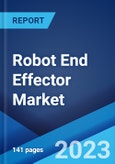The robot end effector, or end-of-arm tooling (EOAT), refers to an additional device, tool or accessory that is attached to a robotic wrist or joint. It is the endpoint of the robot that interacts with the environment and is programmed and designed to perform specific tasks. It includes robotic grippers, tool changers, collision sensors, rotary connectors, pressure tools, compliance devices, burr cleaning tools and arc welding torches. These effectors are commonly used for handling, assembling, welding, dispensing, painting and cutting applications. Owing to this, they find extensive applications across various industries, including automotive, semiconductor and electronics, food and beverage, metals and machinery, chemical and healthcare.
Rapid industrialization and the increasing adoption of robots for industrial operations are among the key factors driving the growth of the market. With the advent of industry 4.0, robots are now increasingly being integrated with advanced technological solutions, such as cloud computing, cyber-physical systems, big data and the Internet of Things (IoT), to optimize the overall efficiency of the industrial processes. Furthermore, the widespread utilization of collaborative robots is also augmenting the market growth. Robot end effectors optimize human-robot work environment, enhance productivity and ensure safe movements of sensitive or fragile products.
Additionally, various technological advancements, such as the improvements in the sensor technology and the development of the pneumatic gripping solutions for high-force applications, are also creating a positive impact on the market growth. Other factors, including the growing demand for modular and electric grippers and increasing deployment of refurbished robots across industries, are expected to drive the market further.
Key Market Segmentation:
The publisher provides an analysis of the key trends in each sub-segment of the global robot end effector market report, along with forecasts at the global, regional and country levels from 2024-2032. Our report has categorized the market based on product, application and end use industry.Breakup by Product:
- Welding Guns
- Grippers
- Suction Cups
- Clamps
- Tool Changers
- Others
Breakup by Application:
- Handling
- Assembling
- Welding
- Dispensing
- Painting
- Others
Breakup by End Use Industry:
- Automotive
- Food and Beverage
- Semiconductor and Electronics
- Healthcare
- Chemicals, Rubber and Plastics
- Metals and Machinery
- Others
Breakup by Region:
- North America
- United States
- Canada
- Asia Pacific
- China
- Japan
- India
- South Korea
- Australia
- Indonesia
- Others
- Europe
- Germany
- France
- United Kingdom
- Italy
- Spain
- Russia
- Others
- Latin America
- Brazil
- Mexico
- Others
- Middle East and Africa
Competitive Landscape:
The report has also analysed the competitive landscape of the market with some of the key players being ABB Ltd., Applied Robotics Inc., ATI Industrial Automation Inc., Bastian Solutions LLC (Toyota Industries Corporation), Festo Beteiligungen GmbH & Co. KG, FIPA Inc., KUKA Aktiengesellschaft (Midea Group Co. Ltd.), Schmalz-International GmbH, SMC Corporation, Soft Robotics Inc., Weiss Robotics GmbH & Co KG and Zimmer Group GmbH.Key Questions Answered in This Report
1. How big is the global robot end effector market?2. What is the expected growth rate of the global robot end effector market during 2024-2032?
3. What are the key factors driving the global robot end effector market?
4. What has been the impact of COVID-19 on the global robot end effector market?
5. What is the breakup of the global robot end effector market based on the product?
6. What is the breakup of the global robot end effector market based on the application?
7. What is the breakup of the global robot end effector market based on the end use industry?
8. What are the key regions in the global robot end effector market?
9. Who are the key players/companies in the global robot end effector market?
Table of Contents
Companies Mentioned
- ABB Ltd.
- Applied Robotics Inc.
- ATI Industrial Automation Inc.
- Bastian Solutions LLC (Toyota Industries Corporation)
- Festo Beteiligungen GmbH & Co. KG
- FIPA Inc.
- KUKA Aktiengesellschaft (Midea Group Co. Ltd.)
- Schmalz-International GmbH
- SMC Corporation
- Soft Robotics Inc.
- Weiss Robotics GmbH & Co KG
- Zimmer Group GmbH
Methodology

LOADING...
Table Information
| Report Attribute | Details |
|---|---|
| No. of Pages | 142 |
| Published | August 2024 |
| Forecast Period | 2023 - 2032 |
| Estimated Market Value ( USD | $ 3 Billion |
| Forecasted Market Value ( USD | $ 8.9 Billion |
| Compound Annual Growth Rate | 12.8% |
| Regions Covered | Global |
| No. of Companies Mentioned | 12 |









